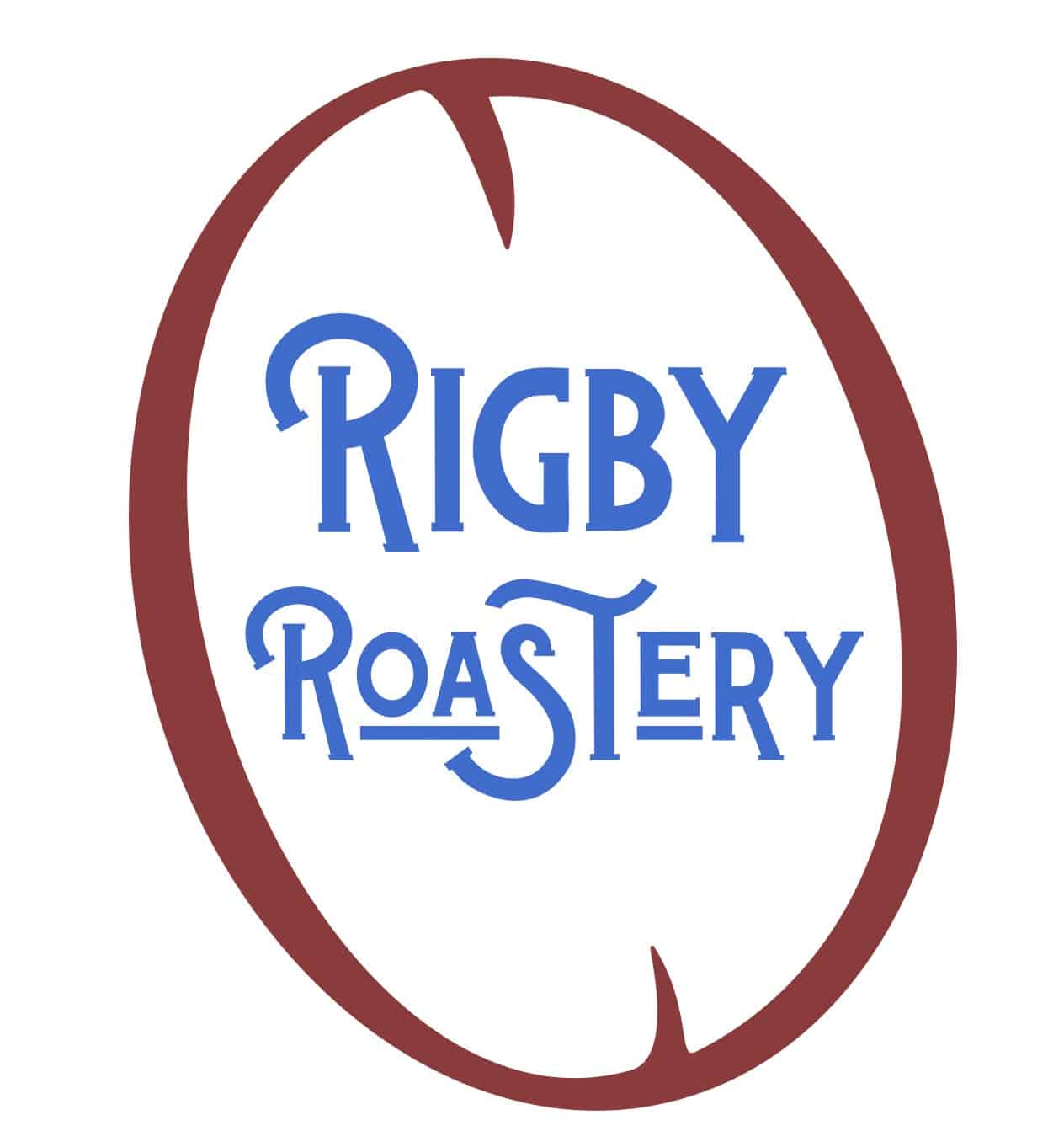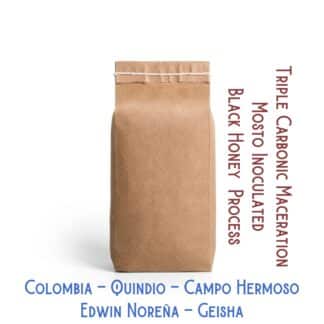Colombia Geisha Coffee Edwin Noreña
Price range: $34.00 through $377.00
This coffee is a Floral Bomb! Jasmine and Orange Blossom are up front. It is sweet, bright, & as complex as they come. Try it today!
Colombia geisha coffee beans for sale. Wilton Benitez coffee. Gesha coffee bean. Unlike haymans coffee, this is fresh roasted.
Floral, Distinctive, and Delicious
Triple-carbonic, mossto-inoculated, black honey process Geisha. There’s a lot going on. The flavor is indulgent. Subtle as well as rambunctious florals collide. Lots of orange blossom and jasmine. Lavender and Lilac are in the mix. Unrefined sugar syrups and sweet herbs alongside ripe white and yellow tropical fruit notes. Edwin Noreña produced this magical nano-lot on his famous farm, Finca Campo Hermoso. Edwin’s alchemy has us enchanted. It’s extravagant. Honeysuckle jam. White ginger. Creamed corn? It is a candied and succulent chaos. Edwin excels and impresses with inventive and unconventional process styles. Most importantly, these methods emerge out of Edwin Noreña’s respect for the combined potential of this coffee’s varietal and terroir.
Edwin’s processing for this particular lot involved three separate fermentations of the whole cherry. Afterwards the coffee was honey processed with a large quantity of the mucilage still attached. Firstly, the fresh picked cherry is fermented on its own. Secondly, the cherries are fermented with more intentional oxygen deprivation. Lastly, the coffee cherry is combined with fermented “must” (the biologicaly rich juice that was collected from the second fermentation and fermented on its own before it is added in the final step).
Finally, just like a traditional dark honey would be, the thrice-fermented cherry is depulped and moved immediately to raised screen beds to dry. Each stage adds a particular bit of uniqueness to the final coffee, so that by the end the coffee is truly unlike any other in the world.
This coffee is a conversation starter. Bombastic, perfumey. Geisha is a floral coffee, but this is some of the most flower forward coffee we’ve ever had. This is a testament to tradition and a nod to what else is possible through consecutive fermentations. Lots of rose, violet, and plumeria leads the way. Spicy geranium.
Perfect for extravagant martinis, espresso extractions showcase complex, piquant flavors that also blend seamlessly with tonics and sours. Ginger and lemongrass are the least in your face of the botanicals present but they enhance the edges of the cup. Zippy wisps of champagne, and tangy candy are aglow under the bright spice of coriander and hints of green rooibos tea.
In pour overs, effervescent hints of Veuve Clicquot champagne and Chimay Triple golden ale disappear into cotton candy and bubblegum sweetness at around 160F.
We especially enjoyed it in a conical pour over. Bust out the V60 or the origami. We recommend you dial back the TDS (about 1.33) and lower the coffee to water ratio (1:16.5) to create more clarity and structure. This produces a complex cup that was also palatable for the average coffee drinker. Or do the opposite and get a dense cup that you can add bypass water to. To open up the cup structure.
Notably, as the grind gets finer it gets a lot bolder and the savory notes become more concentrated. Furthermore, these brews also tend to get more chocolatey while remaining rambunctious.
This one is full of surprises, and fascinates us with every new shot we pull. On espresso, we recommend 20 grams in and 60 grams out at about 16-20 seconds for a tangy acidity and a delicate but creamy body. Tighter shots are less complex but sweet and rich like caramel syrup.
About Edwin Noreña Coffee
In agricultural endeavors, it helps to have vision, possess a persistent attitude, and ultimately understand how to invest your passion into your project in ways that yield significant results. Campo Hermoso is an innovative project operated by a farmer who embodies all of those traits, Edwin Noreña. He is a fourth generation farmer who has seen the industry transform in the last few decades.
Edwin’s willingness to think outside the box and excitement for weaving together tradition with new innovations in agronomical science have only grown. His journey into coffee cultivation and processing in his youth helps him to realize his affinity for coffee farming today. In the last decade, he’s become more focused on technological advances in cultivation and processing. The potential for modernizing coffee farming with advanced methods and new machines while perfecting the tried and true best-practices of his life’s work results in remarkable coffees. They demand the attention of the global community. We are thrilled to offer this rare limited coffee from a fan favorite.
Everything about his operation is cutting-edge. There’s a microbiology laboratory on site alongside the quality laboratory and processing facilities. He grows more than 20 coffee varietals. Firstly, meticulous processes including rigorous selection, sterilization, sorting and characterization of cherries, and an initial controlled anaerobic fermentation are applied to each lot. Even further processing may be applied to the lot according to the most prolific potential profile.
One of the reasons this is such a well-known farm is because Edwin has perfected advanced processing methods alongside his team. Macerating cherries and controling the temperature. His techniques reduce the risk of embryo damage and safeguard volatile compounds that are flavor and aroma precursors by providing for an expertly controlled fermentation. This is the first season we get to feature this coffee, and we are blown away.
Agricultural endeavors are always an exercise in variability and the randomness of nature. It’s a delight to see the hard work and adaptability of a seasoned agronomist coming to life in a harvest like this one.
A recent interview with Edwin reveals some of the method behind his madness. He draws inspiration from wine making and the ways that fermentation can enhance the inherent flavors of the coffee. In the past, methods borrowed from the wine making world, such as carbonic maceration, have proven to enhance the presence of aromatic molecules in the beans.
About the Processing
- Firstly, they pick the Geisha cherries using a brix meter to selectively harvest only the most perfectly ripe fruit. They sort and float them to remove any defective cherries.
- Secondly, they perform a whole cherry fermentation with limited oxygen for 24 hours.
- Thirdly, the coffee is pulped and set for carbonic maceration for 96 hours in large 2000 kilo oxygen deprived tanks.
- Fourthly, the coffee undergoes another controlled anoxic fermentation backslopped with the mossto from the first fermentation. This mossto has been fermented on its own prior to this step to intensify the number of microbes available for this final maceration in smaller 200 kilo tanks.
- Finally, this heavily fermented “black honey” coffee is then taken to dry on raised screen beds in a greenhouse for an additional 10 days, and then stabilized in a climate controlled warehouse for an additional 8 days.
Edwin Noreña Coffee comes from Quindio
Colombia is known for growing beans that are rich in acidity. Certainly, cups of supremo are known for their hearty body and feel. Stone fruit and caramel are common parts of the cup profile. These Geisha coffee beans are all of those things, but with the added bonus of rare genetic cup qualities and immaculate processing.
Quindío makes up only 0.2% of the land mass of Colombia. It is the country’s second smallest department overall. It’s positioned centrally between Bogotá, Cali, and Medellín, the largest and most influential cities there. It is also perched upon the central cordillera of the massive Andes divide. The colorfully decorated towns, majestic tropical landscapes, and high elevation natural reserves draw lots of air traffic and tourism to the region. The lowest elevation points in Quindío are still well over 1000 MASL, and the almost entirely mountainous department is home to a multitude of coffee farms ranging from small family owned plots to large, ambitious projects.
Precious few coffees seem to make it out into the world from Quindío compared to other parts of Colombia. Huila, Columbia produces 200,000,000 kilos of beans annually. It is the top coffee producing department in Colombia with nearly 100,000 family farms covering over 350,000 acres of farmland. Since 2008, Huila has produced more coffee than traditional coffee growing regions Antioquia and the Central Valley. It is also one of the first regions to embrace the specialty market.
Pitalito in the south of Huila is the largest producer of coffee in Colombia. Accordingly, it is home to many Cup of Excellence winning farms. These farms are in a country that is the third largest producer of coffee in the world. It is the largest producer of washed and Arabica coffees. Comparatively, you probably won’t find any robusta in Colombia.
Where else are they growing Colombia Geisha Coffee?
The Cauca region is the cradle of the Colombian massif, which is the source of most of Colombia’s major rivers such as the Cauca and Magdalena. Cauca is closer to the equator so it receives the most possible hours of sunshine throughout the year. It sports a stable climate throughout the year and the farms enjoy the protection of the high mountains from the winds and humidity that comes from the Pacific.
However, growing coffee in this region can be difficult due to the cooler night time temperatures that aren’t common in other areas of Colombia. This is a blessing and a curse though as it slows the ripening of cherries and can enhance acidity and sweet and fruity compounds in the cup.
The Puracé and Sotará volcanoes here enrich the soil with sulfur. Sulfur interacts with the sugars in the beans and creates a caramel, honey, and apple aroma and flavor in the coffee grown here.
Cauca is home to many micro-lots and nano-lots that are unique to the many cloud forests that exist there. The region is a heterogeneous, mountainous place and the smallholder farms here tend to produce unique coffees at different times of the year in different places.
For more delicious coffee beans produced by Edwin, check out this wild Kiwi and Lulo Co-fermented Caturra!
Colombia geisha coffee beans for sale. Wilton Benitez coffee. Gesha coffee bean.

